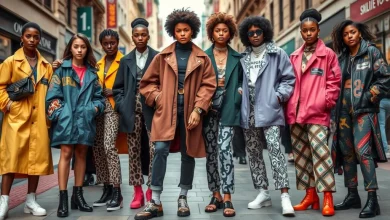
The Rise of Streetwear Aesthetic: A Fusion of Fashion and Urban Culture
INTRODUCTION:
One of the most well-liked fashion fads to hit the streets in recent years is streetwear. Since its introduction in the late 1970s and early 1980s, streetwear has gained popularity among urbanites and fashion-forward individuals worldwide. The emergence of the streetwear aesthetic in the world of fashion has been nothing short of transformative. What began as a neighborhood-based subculture has crossed boundaries and swept the globe. Streetwear aesthetic outfits are the dominant force in fashion today, capturing the attention of both significant people and young people.
No matter your age or gender, streetwear has something for you, from oversized t-shirts and hoodies to joggers and shoes. It’s understandable why streetwear has grown to be such an iconic element of contemporary culture, given its distinctive blend of comfort, style, and attitude. Streetwear has had a remarkable evolution from its humble beginnings as a subculture movement to its current status as a global phenomenon. This article explores the history of streetwear, its inspirations, and how they have influenced modern style, demonstrating the seamless fusion of fashion and urban culture.
The Origin and Evolution of Streetwear Aesthetic
The origins of the streetwear trend may be found in the 1970s and 1980s, when young people from urban locations, especially in New York and Los Angeles, started embracing their unique fashion. Streetwear began as a protest against conventional fashion, drawing inspiration from hip-hop, skateboarding, punk, and graffiti. It signified a genuine expression of uniqueness and innovation that defied convention.
In the 2000s, as high-end fashion brands started infusing parts of urban culture into their collections, streetwear gradually became accepted by the general public. Streetwear labels and luxury companies worked together to add an air of exclusivity to the style. This fusion of high design and streetwear was a turning point for the movement, propelling it into the international spotlight.
Influence of Hip-Hop:
Streetwear aesthetics are profoundly and inevitably influenced by hip-hop. The early streetwear trend was significantly shaped by hip-hop as a cultural and musical phenomenon, and it is still a major driver in its development today. Hip-hop musicians and streetwear designers have worked together and been an inspiration to each other throughout the years .
Hip-hop has grown to be a potent representation of the difficulties and experiences of urban communities. For artists and fans, wearing clothing has become a crucial means to express their uniqueness, cultural pride, and sense of fashion. To capture the carefree and unabashed spirit of the hip-hop movement, hallmarks of hip-hop fashion included baggy pants, oversized t-shirts, hoodies, and sportswear like tracksuits.
Elements of Streetwear:
The appeal of streetwear is found in its variety and adaptability. It skillfully combines convenience, usefulness, and aesthetics and enables people to express their personalities and interests through their attire. The following are significant components of streetwear Graphics and Logos: Bold graphics, eye-catching logos, and distinctive prints are hallmarks of streetwear apparel. These designs often pay homage to street culture, music, and art, serving as a canvas for creative expression.
- Athleisure Influence: Streetwear frequently incorporates elements of athletic wear, fusing functionality with style. Track pants, hoodies, and sneakers are essential components that make streetwear accessible and adaptable.
- Limited Editions and Drops: Streetwear brands frequently release limited-edition collections, or drops,” to create hype and exclusivity. These limited runs drive demand and foster a sense of urgency among consumers.
- Inclusivity and Individuality: Streetwear celebrates individuality and inclusivity. It disregards traditional fashion boundaries, embracing diversity and encouraging self-expression.
- Cultural References: Streetwear often draws inspiration from various cultural references, such as anime, hip-hop, skateboarding, and underground art scenes. These influences add depth and authenticity to the aesthetic.
Pioneer Brands of Streetwear:
During the 1980s and 1990s, several brands emerged as pioneers of the streetwear movement. One of the most influential figures was Shawn Stussy, who started his eponymous brand, Stussy,” in 1980. Stussy’s signature logo, the stylized signature with two S’s, quickly became an iconic symbol of streetwear. The brand’s success was fueled by its connection to surfing, skateboarding, and music culture.
Other brands like FUBU (For Us, By Us), founded by Daymond John and Karl Kani’s eponymous label, became synonymous with streetwear. They played a crucial role in bringing urban fashion to a wider audience. These brands catered specifically to communities that were often marginalized by mainstream fashion, further solidifying the movement’s connection to urban culture.
High-end Collaborations:
Streetwear started to become more widely accepted as the 2000s got closer, and its impact grew beyond its mostly urban origins. It was popularized by pop culture, music videos, and celebrity endorsements. Streetwear became widely accepted due to the use of Adidas tracksuits and shell-toe sneakers by icons like Run-D.M.C. and the Beastie Boys.
Luxury fashion businesses started noticing the streetwear movement’s expanding influence in the middle of the 2000s, and they started adding parts of urban culture into their collections. As a result, high-end fashion labels and streetwear companies began to collaborate in ground-breaking ways. For instance, Louis Vuitton worked with Off-White founder and streetwear genius Virgil Abloh to develop a line that expertly combined luxury with streetwear characteristics.
The success of these partnerships foreshadowed a major change in the fashion business. Streetwear was no longer viewed as a minor fashion trend but as a real and significant player in the industry.
Modern Streetwear:
Today, streetwear has evolved into a multifaceted and diverse genre of fashion. It continues to be shaped by its roots in music, art, and urban culture while also embracing new influences and subcultures. The rise of social media and online communities has played a pivotal role in amplifying impact of streetwear.
Streetwear’s inclusivity and emphasis on individuality have made it a preferred style for the younger generations. It has transcended geographical boundaries and become a global phenomenon. Enthusiasts from all corners of the world eagerly adopting and customizing the streetwear aesthetic to suit their unique tastes and identities.
Contemporary streetwear brands often release limited-edition collections and exclusive drops to create hype and maintain a sense of exclusivity. This strategy has further fueled the demand and excitement around streetwear, with enthusiasts actively seeking out the latest releases.
Social Media Globalization
The advent of social media revolutionized the fashion industry, and streetwear was no exception. Platforms like Instagram and Twitter have become influential spaces for streetwear enthusiasts to share and connect with like-minded individuals worldwide. Streetwear brands leverage social media marketing to build vast communities and create a sense of belonging among their followers.
CONCLUSION:
The rise of streetwear aesthetics owes much of its success and global impact to the profound influence of hip-hop clothing style. Urban culture and fashion have given birth to a dynamic and revolutionary movement that celebrates individuality, creativity, and authenticity. The enduring appeal of the streetwear aesthetic lies in its ability to connect with people from all walks of life. Offering a platform for self-expression and a celebration of diversity. Urban neighborhoods to its global influence, streetwear has redefined the fashion landscape, bridging the gap between luxury and street style. As it continues to evolve and adapt, streetwear remains a celebration of diversity, inclusivity, and the boundless creativity of the human spirit.
Also Read: Best Fruity Smelling Perfumes for Women?









